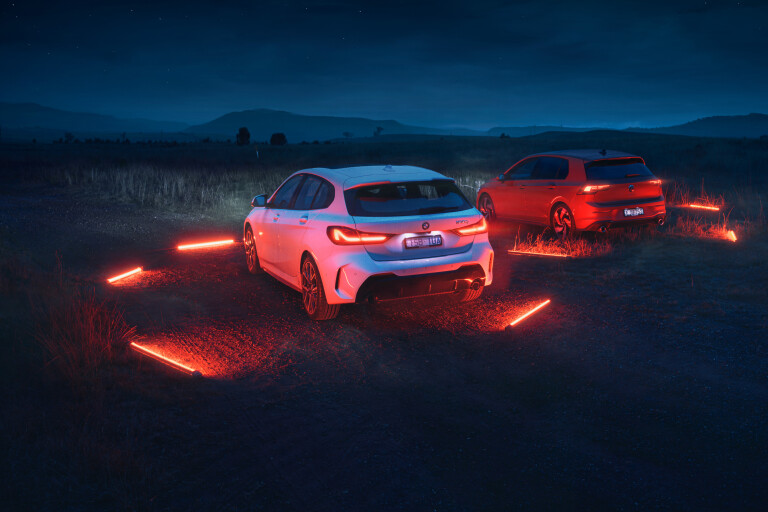
The steady and measured upmarket march of Volkswagen’s Golf and its associated pricing creep won’t surprise many a key observer. Yet it’s still easy to forgive a double take at the sixty-five-thousand-dollar reality that is parking a nicely optioned version of the latest, Mk8 GTI in your car space.
This isn’t some special edition, spec fettled for exclusivity with skunkworks credentials, blessed by the bishop of Wolfsburg or as driven by the captain of Germany’s national football team. This is the regular GTI. In red. With leather.
Through a fairer lens, the $53,100 list price appears a much more palatable entry point for Mk8, replacing its like-for-like Mk7.5 ‘performance-enhanced’ 180kW DCT forebear which was put to pasture at a fiscal high of $47,190.
But as my fully loaded tester’s electric comfort access draws my ventilated Vienna leather pew closer to the fuchsia-mood-lit and bedazzling, digitised dash fascia, I do wonder: what has happened to Volkswagen’s frill-free, everyman’s fun hatchback?
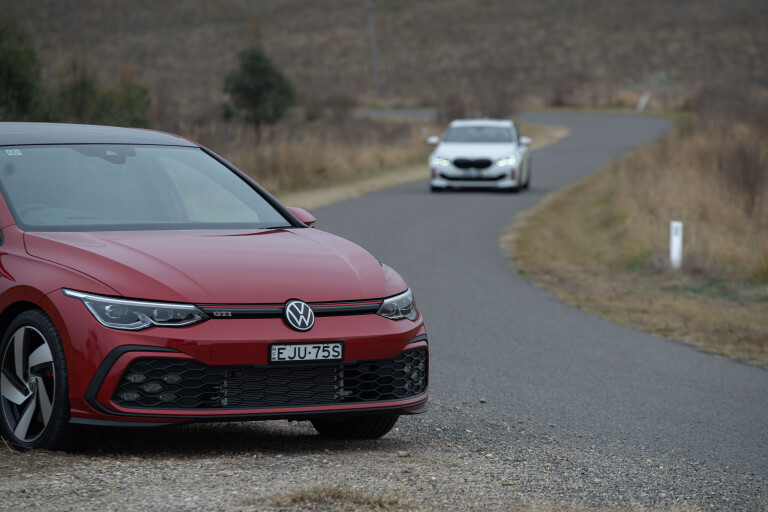
Golf GTI once symbolised something different, its seminal mould minted in the Mk5 of the mid-Noughties in basic, three-door, manual, Tartan-trimmed form. That version’s most authentic extrapolation was the Original, arguably Mk7 at its purest, mirroring its most basic forebear’s door, ’box and trim recipe, if utmost importantly its spirit. It was $37,490 list. Just three years ago.
Now, the GTI is auto and five-door only. So less choice, but a package injected with frills and newfound fanciness to justify its fiscal climb, or vice versa. Despite carrying over much of DNA under the skin, this new Mk8 feels like something of a watershed moment for the nameplate, with aims to shed its working class hot-hatch ethos for aspirations of grandeur.
The BMW 128ti’s arrival arguably carries more gravitas. It’s the company’s first front-driven hot hatch – at least wearing its own branding – reviving an enthusiast nameplate that sat dormant for two decades. Off the tail of the 1 Series’ technical paradigm shift from a rear-driven platform, and courting backlash and controversy, infamously captured in one official line that owners of an ‘ultimate driving machine’ mightn’t be aware which axle provides motivation, there’s a lot riding on this newcomer’s strut tops.
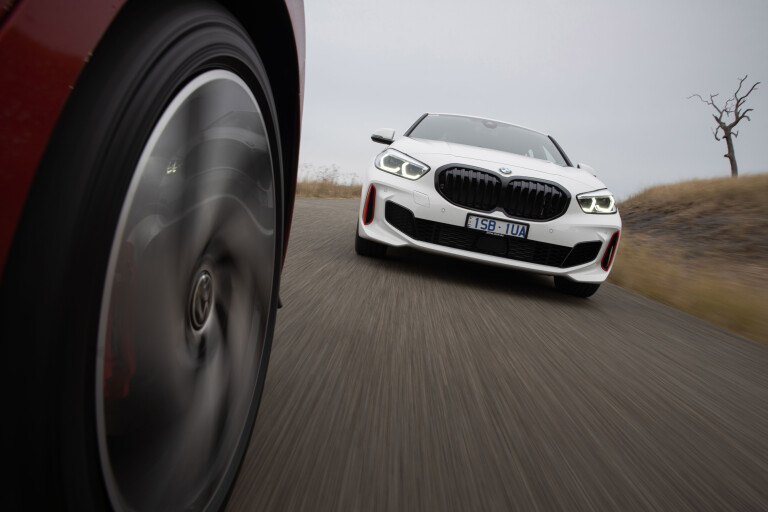
Neither is as fit in local spec as they are as offered in other markets. For the BMW, our version is 15kW and 20Nm down on the car available in Europe. For the Volkswagen, our version carries over the Mk7 ‘Performance’ third-gen EA888.
The potential trap for Munich’s sporty new five-door is appearing as a downmarket move. At $56,900 before on-roads it parks itself right in the GTI’s lane, even if it’s pricier than both the Wolfsburg machine and its own 125i M forebear that came in at less than $50K.
Yet the move to FWD does present BMW with a clean enough sheet for a fair degree of freedom of expression with the 128ti. But rather than applying a heavy hand, its maker appears to have prudently melded sportiness with maturity, a grown-up’s machine that, in the flesh, comes across less as some M-lite proposition and more its own distinctive prospect in the broader BMW line-up.
The GTI’s uninterrupted lineage is both a virtue and a trap. Make no mistake: neat conservatism is utmost to the Golf’s tremendous appeal and ongoing success, its GTI nameplate one of motoring’s greatest icons up there with the Porsche 911. Thus, its applied design is microscopically strategic.

It’s unsurprising, then, that what few Mk8 stylisms do flirt with adventure – eyelash headlights, its mono-brow DRL, omnidirectional Richmond wheels – cause such a big stir. The rest of the GTI exterior form is, beyond anything else, utterly predictable. Then you climb inside...
The new cabin doesn’t so much break the Golf mould – formed through the natural evolution of the three prior generations – as it seems intent on setting it on fire and throwing it off a cliff. And it’s clear that the new cabin aesthetic is primarily tasked with rallying the small hatchback’s march further into upmarket territory.
As pleasingly contemporary as its presentation may be, moving so many minor controls to the new interface is distracting to use, particularly on the move. The digital window dressing bedazzles as intended but it does take a while before it feels intuitive. And importantly, this new theme is a hard departure from GTI’s traditionally classic and somewhat sportier leanings.
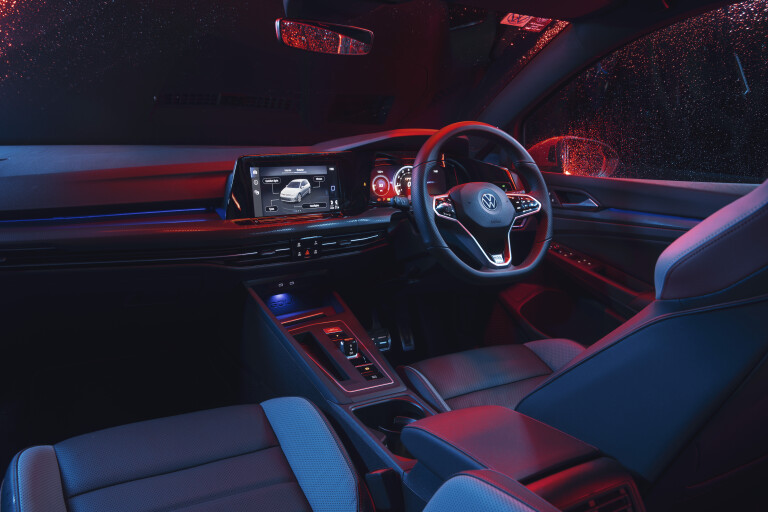
Nor is it some prestigious seachange. The large expanses of door-trim plastic, the switchgear, and the workmanlike Vienna leather, is familiar, middle-grade Volkswagen stuff. However, even those mid-spec bones present well-above the average mainstream hatchback for quality.
The BMW’s cabin brings its own frills, particularly the funky ‘crosshatched’ mood lighting, but overall it’s an interior that’s easier and more intuitive to use while still piling in forward-thinking technical showboating.
In many ways, these protagonists are equals for glitzy cabin features, it’s just the Munich machine is more resolved in execution and offers fewer functionality foibles: traditional volume knob, conventional climate controls, convenient shortcut buttons for the majority of features that need them.
Working against BMW’s favour is the spiralling upcharge for niceties: lumbar and seat/wheel heating adds $1023, the sunroof a further $3000, both as fitted to our test car that’s on the fast track to $70k on-road. For both cars, avoiding expensive options seems far more sensible and compelling given the hot-hatch space they aim to occupy.
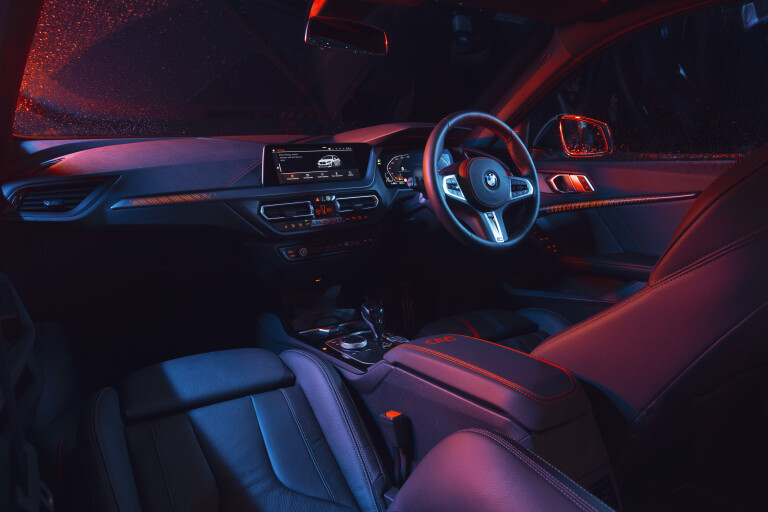
The pair level nicely under their bonnets. Both turbocharged 2.0-litre four-pot engines produce 180kW from 5000rpm, the BMW maintaining its peak a little higher in the top end (6500rpm plays 6200rpm). Of the two, the BMW plies an extra 10Nm for a 380Nm total, though in similar peak bands: 1500-4400rpm for the 128ti, 1600-4300rpm for the GTI.
Equally, neither is as fit in local spec as they are as offered in other markets. For the BMW, our version is 15kW and 20Nm down on the particulate-filter-equipped car available in Europe. For the Volkswagen, our version carries over the Mk7 ‘Performance’ third-gen EA888 rather than the newer Evo4 development now fitted to the Euro GTI, offering identical 180kW and 370Nm peaks, if with cleaner credentials and a freer-revving nature.
Performance penalties? A marginal adjustment on advertised claims, the 128ti 0.2sec slower to 6.3sec and the GTI nipped 0.1sec to 6.4sec for the 0-100km/h measures in transition to Oz spec. Given both protagonists related engines offer higher outputs elsewhere – 225kW in M135i, 213kW in Mk7.5 Golf R – suggests headroom is available for future enhancement.
Seat of the pants, they’re equally strident on the march. Loaded up on the pedals, the GTI holds 3000rpm, its ‘wet’ dual-clutch dipping rpm to just above 2000rpm when stepping off the brake pedal, swinging into maximum thrust of an engine seeming sweeter in its top end.

The electro-mechanical LSD plies traction well from the 225mm Bridgestone Potenzas, with just a modicum of traction loss, the Golf shooting straight and true with barely a hint of torque-steer.
The 128ti is more eager out of the hole, its eight-speed auto less mechanically sympathetic, the turbo four manning battle stations more swiftly and assertively in the mid-range. Both hatches are supremely linear in acceleration, their transmissions crisp and precise in upshifting, though it’s the BMW that tugs more eagerly at the tiller feeding torque across its axle, more in liveliness than sheer struggle, its own mechanical LSD keeping those 225 Michelin Pilot Sport 4s drilled to the hot-mix.
The BMW’s punch does have to contend with more mass, its 1445kg kerb weight heftier than the 1409kg Volkswagen. They’re equally and satisfyingly swift, neither seemingly stealing the march for real-world pace. But in most every other respect, they’re distinctly different animals on road.
Characteristically, the GTI doesn’t fall far from the family tree. Its measured character is so evenly tempered that it almost comes off as being bland, but lean into it and its dynamic talent swells to the surface confidently.
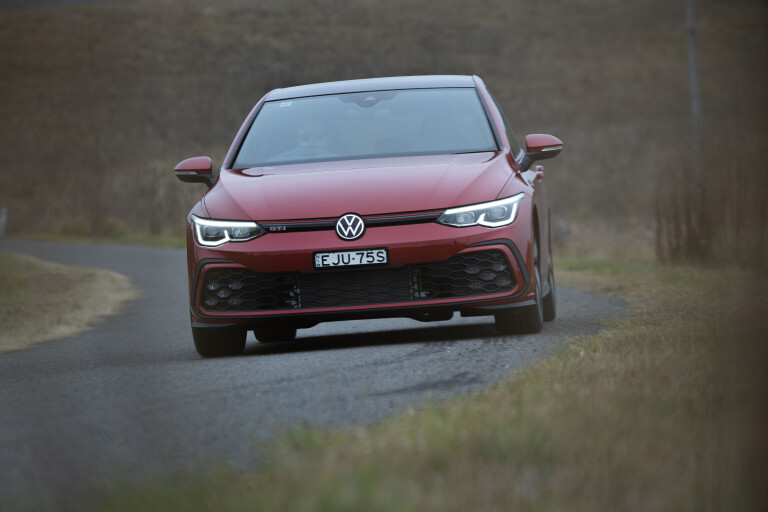
The steering is pure GTI, rounded and linear, an ally of detailed accuracy. It’s married to a chassis that’s clear and connected without tipping too far towards unruly pointiness or languishing into benign lethargy. It feels trustworthy and eminently friendly in its organic nature despite the newfound electronic talent injection, which goes some way in justifying the hot Golf’s price rise.
The chassis’ key update is the Vehicle Dynamics Manager system that governs the electronic ‘XDL’ brake-based wheel control and Adaptive Chassis Control smarts in cahoots with the electro-mechanical limited-slip differential. Volkswagen claims this “in effect entirely eliminates understeer” and the GTI may well demonstrate clear improvement let off the chain on a racetrack, but on road, cutting curves at a dull roar, it’s so transparent that what benefit it brings goes largely unnoticed.
The more conspicuous party trick is the 15-stage damper tuning, from softer than Comfort to tauter than Sport, distractingly accessible via submenus in the touchscreen, if thankfully adjustable on the fly. Its ride comfort scope covers middling to sharp in fine increments, but it’s well executed and allows tuning fine enough to appease the fussiest whims.
GTI’s new talents are so subtly effective that, in practice, fast-flowing back roads that are both smooth or lumpy are best tackled with a Comfort chassis setting, which strikes a fine blend of pliant ride with deft wheel and body control without sacrificing engagement and accuracy. In this setting, this really is the Golf GTI at its grand touring finest.

As innocuous as it may look, the 128ti lays on the mojo much thicker, but not in some flippant or ham-fisted manner. It delivers its pulse-raising hot-hatch pitch without apology while maintaining a strong sense of premium maturity.
At the helm, the BMW feels cosier and more compact than the airy and measured Volkswagen, where you feel pinned into the control of its heightened responses. It’s more hard-wired into the driving experience, more analogue and mechanical in connecting the driver to the road.
The 128ti’s steering is more instantly reactive off centre, and it pairs with a front end that is more alert than its rival, with a hair more granular feedback that blends beautifully with the bite of those excellent, tenacious Michelins. Despite its weight disadvantage, the BMW is keener to change direction and it dances about more eagerly than the comparatively sure-footed and almost-benign Volkswagen, at least at a spirited clip that won’t threaten your driver’s licence.
Each has the measure of the other for point-to-point pace and engagement while doing so. But it’s the BMW that brings a larger sense of enthusiasm, seducing you more into pushing on and exploring its lively dynamic talents, compounded by the turbo four’s eagerness to punch quickly out of corners, the chassis’ consummate traction harnessed with aplomb by the limited-slip hardware.
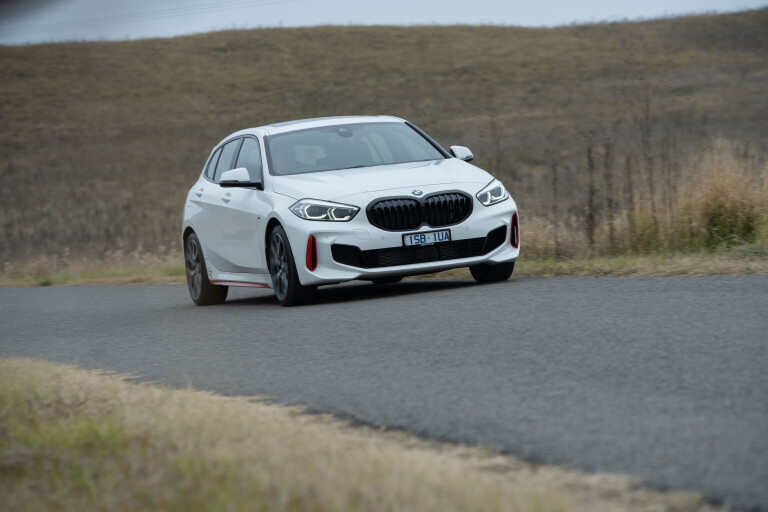
What the BMW lacks for a more fully rounded dynamic character is adaptive or switchable damping. It makes do with a particularly firm fixed setting that, at least with its scruff grabbed firmly in the thick of the twisties, yields just enough compliance to ply strident tyre adhesion across sharp mid-corner bumps while maintaining fire for the frisky dynamics.
The 128ti is something of a surprise, mostly because experiences of the brittle and inert 118i or the decent if dynamically underbaked M135i xDrive soften expectations. The 128ti is a huge improvement on either stablemate, the 1 Series finally finding properly impressive form. And while the jury is out for on-track talent, just quite how lean, crisp and thoroughly resolved BMW’s first properly hot front-driver is out of the box is quite the eye-opener.
Yes, the BMW’s ride quality is terse around town, incessantly jiggly at low speed, slappy across square hits and expansion joints. But it’s not entirely out of place for the sort of charisma it confidently owns. The flipside, however, is that for the sort of money the 128ti asks for and as the premium proposition it wants to be considered, switchable ride comfort should be standard issue.
The GTI’s multifaceted suspension smarts is the key area where it asserts itself as an incredibly accomplished all-rounder. And it lays on the cabin pizazz and brings newfound smarts to its resolved driving experience. It’s certainly equally as capable of covering ground in fine and suitably hot form as its BMW nemesis does. But in attempting to cover more bases more emphatically, it’s a little less complete. It’s here, more than anywhere, that the Golf hands the narrow win to the 1 Series.
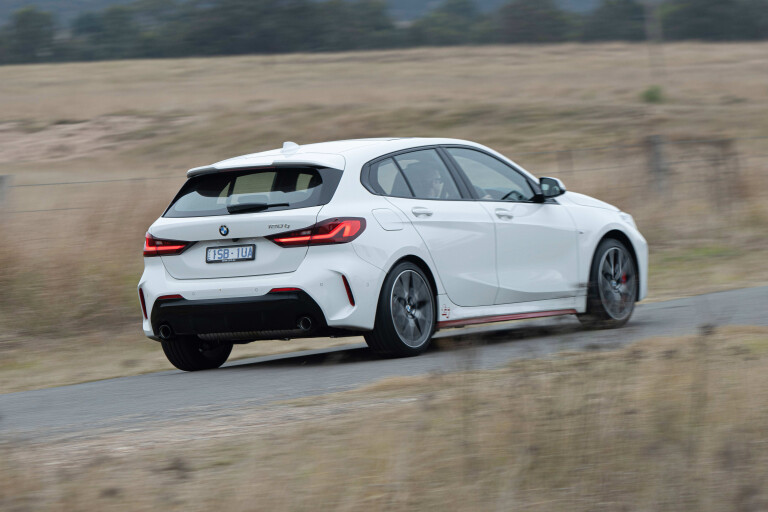
Our test VW misses the mark on its home stretch: an exhaust with an irritating resonant boom at a light-throttle cruise, an inductive charge unit that sent your author’s iPhone into meltdown, as well as the approach to user interface that makes the Volkswagen a little frustrating to live with. There’s room for improvement in the GTI’s execution and this does impact its upmarket aspirations.
The 128ti is simply better executed, as if it graduated finishing school with slightly higher honours. And that its athletic streak is clearer and more accessible across a broader range of driving situations demonstrates a stronger conviction to nailing its hot-hatch intent to the mast.
In what it does, perhaps moreso than how it looks, the BMW brings an X-factor in the drive that’s a little lacking in its rival. And it does so without detriment to genuine premiumness and maturity. On these alone, Munich’s fledgling hot hatch goes a fair way in justifying the steeper ask than that of its rival.
Rebooting BMW’s long-dormant ti suffix wasn’t a move that added pressure or an expectation that there was something to prove. That the marque’s new front-driven offering carves a fresh and inimitable niche in its line-up, and enriches the broader hot-hatch gene pool with a compelling new spin, adds a little extra weight to win here against Volkswagen’s iconic stalwart.
VERDICT
BMW 128ti: 8.5/10
Volkswagen Golf GTI: 8/10
| Make/Model | BMW 128ti | Volkswagen Golf GTI |
|---|---|---|
| Price | $56,900 / As tested $63,473* | $53,100 / As tested $58,700* |
| Drivetrain | ||
| Engine | 4cyl, dohc, 16v, turbo | 4cyl, dohc, 16v, turbo |
| Layout | front-engine (east-west), front drive | front engine (east-west) front-drive |
| Capacity | 1998cc | 1984cc |
| Power | 180kW @ 4750-6500rpm | 180kW @ 5000-6200rpm |
| Torque | 380Nm @ 1750-4500rpm | 370Nm @ 1600-4300rpm |
| Gearbox | 8-speed automatic | 7-speed dual-clutch |
| Chassis | ||
| Body | steel, 5 doors, 5 seats | steel, 5 doors, 5 seats |
| L/W/H/W–B | 4319/1799/1434/2670 | 4287/1789/1463/2631mm |
| Track (F/R) | 1560/1563mm | 1535/1513mm |
| Weight | 1445kg | 1409kg |
| Boot | 380L | 374L |
| Fuel/Tank | petrol/50 litres | petrol/50 litres |
| Economy | 6.8L/100km (ADR combined) | 7.0L/100km (ADR combined) |
| Suspension | Front: struts, A-arms, anti-roll bar. Rear: multi-links, coil springs, anti-roll bars | Front: struts, A-arms, adaptive dampers, anti-roll bar. Rear: multi-links, coil springs, adaptive dampers, anti-roll bars |
| Steering | electrically assisted rack-and-pinion | electrically assisted rack-and-pinion |
| Front Brakes | 360mm ventilated discs | 340mm ventilated discs |
| Rear Brakes | 330mm ventilated discs | 310mm ventilated discs |
| Tyres | Michelin Pilot Sport 4 | Bridgestone Potenza S005 |
| Tyre Size | 225/40 R18 (f/r) | 225/40 R18 (f/r) |
| Safety | ||
| ANCAP Rating | Five stars | Five stars |
| Performance | ||
| 0-100km/h | 6.3 (claimed) | 6.4sec (claimed) |
| ** Comfort package ($1023); ‘Dakota’ leather ($2200); glass sunroof ($2000); Harman/Kardon audio ($1350) | ** includes metallic paint ($300); Sound & Vision Package ($1500); Luxury Package ($3800) |



COMMENTS